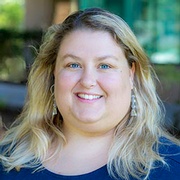Service: Sharing Back, Learning Forward
By Lilly Thomas | January 4, 2019
Customer Service/Sales, ETR
I have the brain of a sociologist. I’m interested in other people, in their day-to-day lives. I’m curious about how people live in different parts of the country—how they talk, what they eat, how they connect with one another.
I got my college degree in urban planning, which I call “sociology with solutions.” I’ve always made the effort to integrate my formal education with service experiences. This is part of my make—I feel that I’ve been offered privileges that make it morally necessary for me to share back. One of the great benefits of this is that not only do I feed my curiosity about other people’s lives, I learn a lot about my own.
Joining AmeriCorps felt like my next natural step for my life after college. I wanted to test the waters of my interest in education. I got to do this in Santa Cruz County at Ceiba College Prep, a grade 6-12 charter school in Watsonville. I learned there that classroom teaching was not for me and decided to use my interest in service and the vessel of AmeriCorps to try something else new.
New Learning in Baltimore
I wanted experience beyond my own region, so for my next AmeriCorps project, I travelled from Santa Cruz to Baltimore. I worked as a caregiver in a subsidized housing care facility. The residents were mostly African American, mostly men, some veterans, but all had contracted and were currently living with HIV.
This facility, over its own history, was as ever-changing as the HIV epidemic itself. In its creation, it was known as a safe place that would take care of you as you died from the virus. Today, most of the residents will live there for 9-10 years. They aren’t just “passing through.” They are in a community.
I started my service experience with all the answers, of course! I would cut out all sugary drinks from their daily ritual, bring in enrichment like crafts and puzzles, and switch out their chain smoking with sliced vegetables.
I came up against a lot of resistance (obviously). As the months went by, I gave into their requests for fruit punch and orange soda, watched Ravens games and ID (Investigation Discovery) Network on repeat and joined them in conversation on the sprawling porch while they bought cigarettes off neighbors passing by. I slowly accepted that these lifestyle comforts—things I saw as detriments to their health—were matters over which I had not much control.
Insisting they change was an oppressive way to come into my experience of service. Instead, I had to meet them where they were at. I needed to give dignity to the life they had lived and the life they would continue to live. The services I was there to provide—clean clothes, regulated medication and warm food—were the things that made the difference in these folks’ lives. The alternative would have been homelessness and lack of health care. It was an ongoing lesson in humility for me, and a continued lesson in how frustrating systems of poverty can be.
Working at ETR: Also a Kind of Service
I’ve been working here at ETR for about six months now. This has turned out to be a good fit for me—an extension, in some ways, of the service work that has been so important in my life. As a customer service representative, I spend time talking to people who are serving some of the same populations I’ve worked with. And I know I am talking to customers who see those same systems and cycles of poverty, as well as addiction, discrimination and economic inequality. These are people trying to meet their community’s direct needs.
I’ve been in other customer service jobs where I never knew what to expect from a call. Sometimes I’d be wondering, “Am I being trolled? Are they just seeing how far they can push me?” Here, our customers’ first priority is their students, clients or patients. They don’t want to harass the person answering the phone. They have bigger fish to fry! And they are usually under constraints (budget, bureaucracies, time, etc.). They just want information about the products that will be of use to them.
This is one of the points where being a non-profit can be really helpful. We’re big enough to be efficient and small enough to be flexible. We care about the work our customers are doing—we know they’re making a real difference in their communities. We do everything we can to smooth the process for them.
Along with our flexibility with our customers, I find the environment here at ETR very flexible and open. Our Project Editor Laura Perkins is always so responsive to customers who have questions or suggestions about the information provided in our pamphlets. Materials Procurement Manager Sterling Clark can always “make something work” when it comes to fulfilling orders and custom prints. I could name a dozen other people who are part of the support network for our customers. It is super rad to have so many ETRians in my back pocket to help problem solve!
ETR is also an organization that leads by example when it comes to equity The culture here supports a healthy, balanced life. We have health care and other benefits. We have paid PTO.
ETR offers a good mix of my interest in education and passion for public health. I still have so much to learn. I am grateful to have the opportunity to advocate for such fine products, and I am happy to put my energy here.
Lilly Thomas is a Customer Service/Sales Representative at ETR. She can be reached at lilly.thomas@etr.org.





